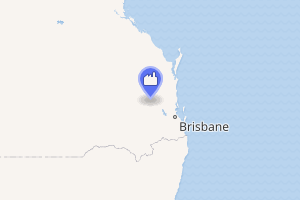Tarong Power Station
The Tarong Power Station is a coal fired power station located on a 1,500 hectares (3,700 acres) site in Tarong in the South Burnett Region near the Burnett River and Nanango, in Queensland, Australia. The station has a maximum generating capacity of 1,400 megawatts, generated from four turbines. Coal is supplied via a conveyor from Meandu Mine, which is 1.5 kilometres (0.93 mi) away and is also owned by Stanwell.
| Tarong Power Station | |
|---|---|

Location of the Tarong Power Station in Queensland, Australia | |
| Country | Australia |
| Location | Tarong, Queensland |
| Coordinates | 26°46′52″S 151°54′54″E |
| Status | Operational |
| Construction began | 1979 |
| Commission date | 1 Unit: May 1984 2 Unit: May 1985 3 Unit: February 1986 4 Unit: November 1986 |
| Construction cost | A$1.23 billion |
| Owner(s) | Stanwell Corporation |
| Thermal power station | |
| Primary fuel | Bituminous coal |
| Power generation | |
| Units operational | 4 × 350 MW |
| Make and model | Hitachi |
| Nameplate capacity | 1,400 MW |
| External links | |
| Website | stanwell |
Construction and design
It was decided to build a new power station at Tarong in 1978, with work beginning in the following year.[1] Initially it was expecting to be operating by October 1985 but this date was brought forward by 17 months to cover the expected growth in demand. 1 Unit was commissioned in May 1984, with 2 Unit following exactly 12 months later. 3 Unit was commissioned in February 1986, and finally 4 Unit was commissioned just 9 months later in November 1986. Thus the accelerated construction program included not only bringing forward the dates, but also compressing the timeline.
The design included Queensland's first hyperbolic natural draught cooling towers which rise to 116.5 m. The power station has one chimney which is 20 m in diameter and rises 210 m.[1] There are two control rooms. The total construction cost including water supply facilities was A$1,230 million.
Emissions
The power station was the site for a pilot project which had been expected to reduce emissions by 1000 tonnes per year by collected carbon dioxide from flue gases.[2] The project was developed by CSIRO.
A second trial to capture greenhouse gas emissions was conducted by MBD Energy. The technology being trialled collected carbon dioxide and pumped it into waste water where it synthesised oil-rich algae into edible seaweed products or oils.[3]
Demand reduction
In October 2012, Stanwell announced plans to shut down two generating units for two years.[4] The electricity market was oversupplied and wholesale electricity prices were relatively low.[5] The scaling down of operations resulted in the loss of employment for some workers. Both units have since been successfully restarted.
Return to service
Because of higher natural gas prices in 2014 power generators turned to coal-fired power.[6] In July 2014, one of two units shut down in 2012 returned to service. The recommissioning task was a first for a turbine of that type and took 20,000 hours to complete.[6] The second turbine is expected to be operating by 2015.
References
- Dunn, Col (1985). The History of Electricity in Queensland. Bundaberg: Col Dunn. pp. 169–170. ISBN 0-9589229-0-X.
- Sophie Benjamin (3 December 2010). "Tarong Energy and CSIRO launch carbon capture plant". ABC Southern Queensland. Australian Broadcasting Corporation. Retrieved 5 August 2011.
- Tracy Lee (1 August 2011). "Carbon-capture support spurs MBD's $100m IPO". The Australian. Retrieved 5 August 2011.
- "Jobs go as Tarong power station winds back". Brisbane Times. 11 October 2012. Retrieved 19 November 2012.
- Jordan Philp (5 February 2014). "Tarong brings units out of cold storage". The South Burnett Times. Retrieved 30 July 2014.
- Eric Tlozek (3 July 2014). "Electricity providers return to coal-fired power as natural gas export revenue soars". ABC News. Retrieved 30 July 2014.
- http://www.stanwell.com/news/incident-tarong-power-station/